When ordering locks, you will most likely need to specify the type of cylinder you need. The list of options is a long one: mortise, rim, key in knob, key in lever, deadbolt, and profile. But don’t let this throw you – it’s pretty easy to distinguish each of the types of cylinders.
Before we define the cylinder types, a bit of basic lock component education will go a long way. The terms cylinder, core, and plug are often [incorrectly] used interchangeably. The descriptions can be a bit technical, so rather than confusing you with words, I’ll let this picture do the talking.
Now onto the business at hand – let’s make sense of the different types of cylinders.
Types of Cylinders – Mortise Cylinder
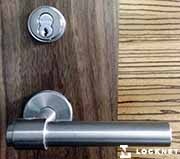
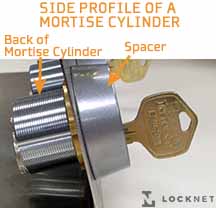
Mortise cylinders are round threaded cylinders that screw into the lock body. Depending on the depth of the cylinder,you may need to install spacers to make the cylinder flush with the lock. Mortise cylinders are available in both standard keyway and interchangeable core formats.
Types of Cylinders – Rim Cylinder
 Another common type of cylinder is the rim cylinder. It is generally only used in exit devices. It looks similar to a mortise cylinder but has a long tailpiece on the end. Ninety-percent of the time, if you have an exit device with keyed access from the outside, you will need to order a rim cylinder. However, there are certain types of outside trim and exit device brands that use mortise cylinders. Much like mortise cylinders, rim cylinders are available in both standard keyway and interchangeable core formats.
Another common type of cylinder is the rim cylinder. It is generally only used in exit devices. It looks similar to a mortise cylinder but has a long tailpiece on the end. Ninety-percent of the time, if you have an exit device with keyed access from the outside, you will need to order a rim cylinder. However, there are certain types of outside trim and exit device brands that use mortise cylinders. Much like mortise cylinders, rim cylinders are available in both standard keyway and interchangeable core formats.
Types of Cylinders – Key in Knob/Lever Cylinder
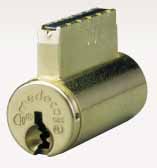 A key in knob/lever cylinder is what you see on a regular knob lock or lever set. The cylinder is what holds the portion of the lock into which you insert your key. If the cylinder is removed, a standard keyway cylinder would look like a variant of the picture to the right. It may be a bit longer or shorter, and the end may look slightly different depending on the brand of lock. The depth of the cylinder is determined by the depth of the lever, and the end is determined by how the cylinder engages the locking mechanism of the lever. Levers and knobs that use interchangeable cores are made differently and won’t accept standard cylinders.
A key in knob/lever cylinder is what you see on a regular knob lock or lever set. The cylinder is what holds the portion of the lock into which you insert your key. If the cylinder is removed, a standard keyway cylinder would look like a variant of the picture to the right. It may be a bit longer or shorter, and the end may look slightly different depending on the brand of lock. The depth of the cylinder is determined by the depth of the lever, and the end is determined by how the cylinder engages the locking mechanism of the lever. Levers and knobs that use interchangeable cores are made differently and won’t accept standard cylinders.
Types of Cylinders – Deadbolt Cylinders
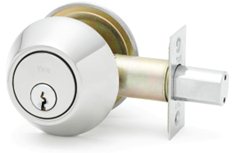 Another type of cylinder most of us use every morning when heading out the door is the deadbolt cylinder. From the outside of the door, a key must rotate the cylinder to retract the deadbolt. The inside of a deadbolt can be operated with a thumb turn or key depending on which option you order.
Another type of cylinder most of us use every morning when heading out the door is the deadbolt cylinder. From the outside of the door, a key must rotate the cylinder to retract the deadbolt. The inside of a deadbolt can be operated with a thumb turn or key depending on which option you order.
Types of Cylinders – Profile Cylinder
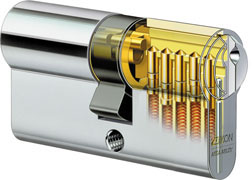 Profile locks are common in Europe, but aren’t frequently used in the United States with the exception of storm doors. They are available in oval or tear drop shapes with a cam in the middle that operates both sides of the lock.
Profile locks are common in Europe, but aren’t frequently used in the United States with the exception of storm doors. They are available in oval or tear drop shapes with a cam in the middle that operates both sides of the lock.
That wasn’t so bad was it? Next time you’re ordering parts you should be able to rattle off your cylinder type like an industry veteran. Did we miss anything? Still confused or have questions? Leave a comment below.


The parts included in the typical mortise lock installation are the lock body (the part installed inside the mortise cut-out in the door); the lock trim (which may be selected from any number of designs of doorknobs , levers , handle sets and pulls); a strike plate , or a box keep, which lines the hole in the frame into which the bolt fits; and the keyed cylinder which operates the locking/unlocking function of the lock body. However, in the United Kingdom, and most other countries, mortise locks on dwellings do not use cylinders, but have lever mechanisms.
this is very informative site. Thank you. quick question. I have new lock set (Halifax from Kwikset) but then it uses 5 PIN (Pin and tumbler) my condo uses SC4 type 6PIN. (I believe Schlage 6 PIN )
I see that TAIL pin (cam) can the length of that piece be CUT to accommodate overall fitting lengh? that is if 6 pin cylinder since it is longer then 5 pin then you cut tail pin smaller to keep over all length . is that done often? Thanks for any help